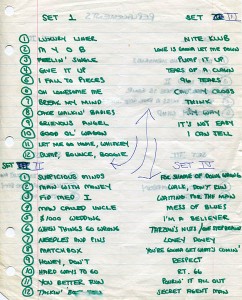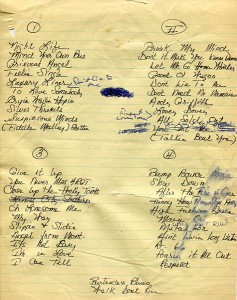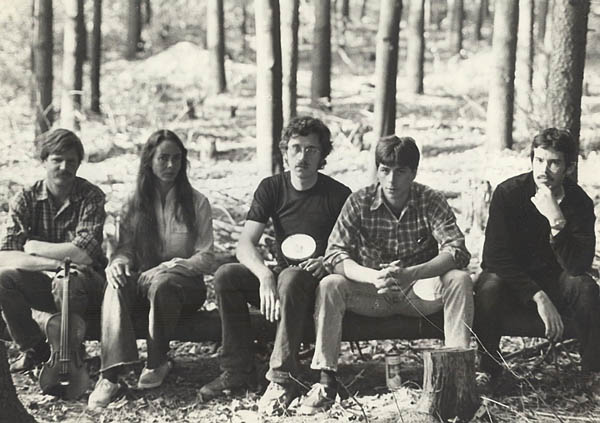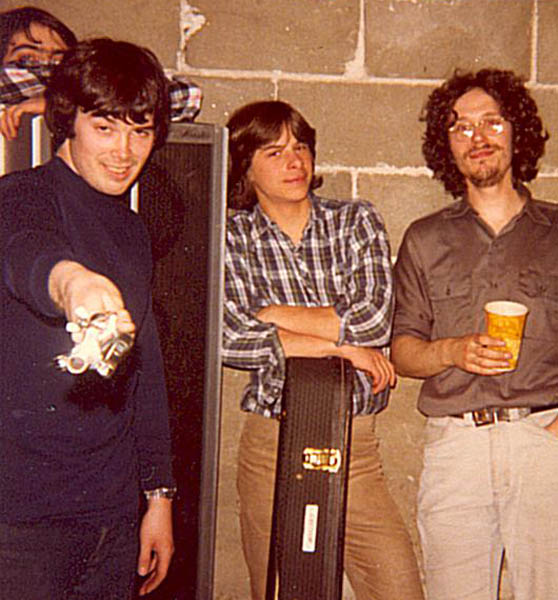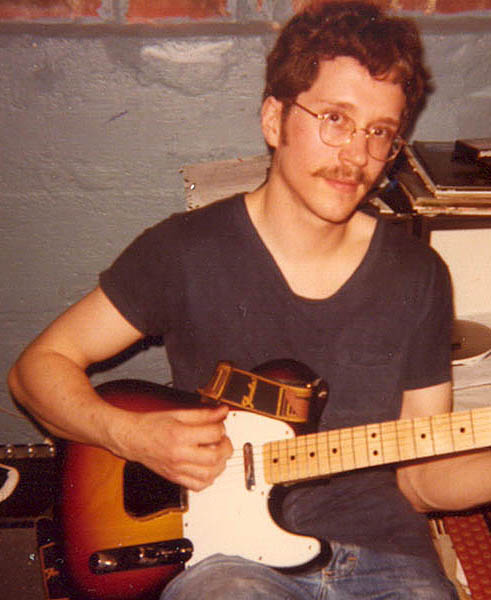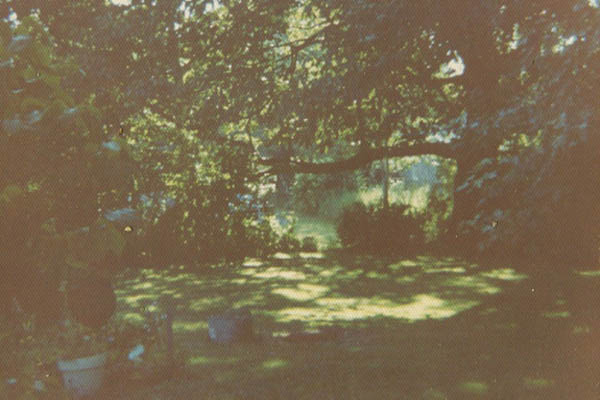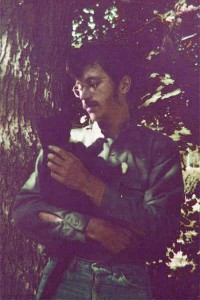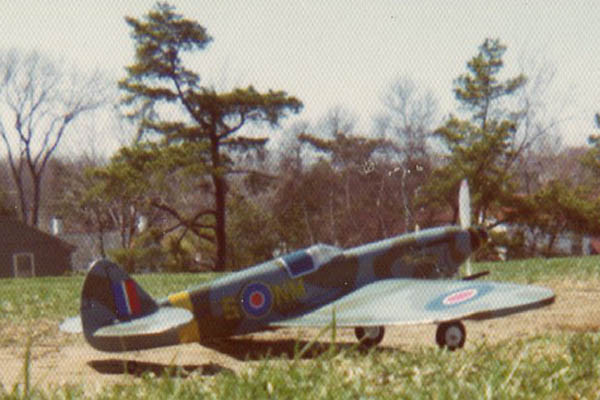We’ll Be Your Mirrors
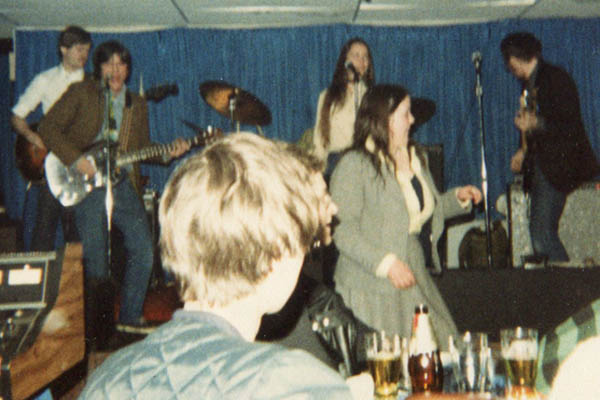
The Mirrors at the Downtown Lounge, 1980. From left: Jim Sullivan, Mike Piscopo, Chris Hanson, Doug Hubley. Concealed by Chris is drummer Ken Reynolds. Photographer unknown.
In music, as in so many other things, I can’t make up my mind.
In virtually every style* of music I hear, I hear something to like**.
And because I want to play music that I want to hear, my stylistic promiscuity has been a problem over the years. Not all listeners, or bandmates, are as restless as I am. And in any case, extreme eclecticism is difficult to pull off. It requires strong chops, discerning taste and the kind of musical personality that can unify disparate influences. (Well, one out of three is better than none: I have pretty good taste.)
My current band, Day for Night, plays only country — but when we were starting out, in the mid-2000s, we had a country set and a bossa nova set. Because it took me about two months, on average, to work out a new bossa nova song (lacking the strong chops, you see) the set became stale and we got realistic and bagged it. I don’t know where we ever could have performed a night of bossa nova and country, anyway.
But back in the day I wasn’t so sensible. The Mirrors, my first somewhat professional band, had the eclecticism problem about as bad as could be. The arc of a typical Mirrors performance was reasonable enough, starting out blue and quiet, ending red and electric. But in between we veered all over the map.
The set list at right, from 1980, will give you some idea. It includes:
- Country songs by Gram Parsons with Emmylou Harris and the Flying Burrito Bros., Hank Williams, George Jones, Don Williams, Patsy Cline, Asleep at the Wheel
- Blues and R&B by Bonnie Raitt, Bessie Smith, Elvis Presley, the Clovers, Otis Redding
- Vintage pop and rock by Presley, the Searchers, Carl Perkins, the Rolling Stones, ? and the Mysterians, the Ventures, the Monkees, Bobby Troupe, Johnny Rivers, the Rascals, Bo Diddley
- Then-contemporary rock by the Fabulous Poodles (their interpretation of the Everly Brothers’ “Man With Money”), Elvis Costello, Robin Lane and the Chartbusters, the Specials, the English Beat (their version of Smokey Robinson’s “Tears of a Clown”), Madness, Pat Benatar, Graham Parker
- And songs by the Velvet Underground, Richard Thompson, Jimmy Cliff and Frank Sinatra.
All that jumping around, in addition to a penchant for instrument-swapping that seriously slowed the pace, must have made some early Mirrors performances exasperating. (I still cringe at the memory of taking long minutes to retune the guitars to the Farfisa rock organ for the sake of one or two songs.) I remember someone’s graffiti in the men’s room of the original Downtown Lounge, in the Plaza Hotel: “The Mirrors suck.”
I guess I can see why someone would say that, in view of one or two of our DTL performances: an anti-nuclear-power benefit where I had laryngitis but tried to sing anyway, or the 1980 Corner Night where we were fine, but just hopelessly tame compared to the Foreign Students and the Pathetix. And we had other issues in addition to the stylistic indecisiveness.
But in spite of sucking, which we really didn’t most of the time, the Mirrors always got work. In 1980, our last year together, working for Maine country impresario Slim Andrews as well as getting our own dates, we were gigging all the time, from Kittery, in southern Maine, to Guilford, 182 miles away. Venues ranged from the punkish DTL (located in the Plaza, which stood where the Portland Public Market building is now) to York Animal Kingdom.
And, as will happen, we learned a lot and got a lot better, not only musically but professionally (even if we did ignore Slim’s injunctions against drinking and wearing sneakers on stage).
So, yes, looking back, I see things we could have done differently. But overall I don’t regret the way it played out. In the greater perspective, in fact, the Mirrors served me, and I hope some of my bandmates, the way your first big failed affair serves the remainder of your love life. It teaches you how to do what’s right and how not to do what isn’t, all on the stage of a grand romantic fantasy that gradually becomes your reality.
And in the short term, the Mirrors led directly to the Fashion Jungle. Among the things we learned were the facts that we wanted to concentrate on rock — and on our own material. About which, more next time.
Here are two of the three original songs the Mirrors ever performed, all by yours truly. Someday, when I am in a mood to give the Harry Fox Agency large dollars to license other peoples’ music, I will post a few Mirrors covers as well.
“You Know How It Is” and “Maine State Pier Blues” copyright © 2010 by Douglas L. Hubley. All rights reserved.
The Mirrors*, 1979-1981
Christine Hanson, vocals and percussion
Doug Hubley, guitar, bass, organ and vocals
Mike Piscopo, bass, guitar, organ and vocals
Ken Reynolds, drums and vocals
Jim Sullivan, fiddle, guitar, bass, organ, saxophone and vocals
*In our last months, we were known as the Karl Rossmann Band, after the protagonist in Kafka’s Amerika. We were sick of the name “Mirrors” and used a ranked-ballot system to select a new one. The other contenders included “Goats of the Trapezoid,” Ken’s tribute to Birdsongs of the Mesozoic, and “Cadence.”
* Chainsaw metal, ragtime and pop a cappella being towering exceptions.
** People who know me well may be laughing at this point, having heard me mutter “I hate this song” or “I hate this group” repeatedly anywhere music can be heard. Yes, I’m annoyingly picky about specific songs and musicians, and in fact dislike most of them. But here I’m talking about musical styles.
Text copyright © 2012 by Douglas L. Hubley. All rights reserved.
